- Renewable Energy
- Posted
Static electricity
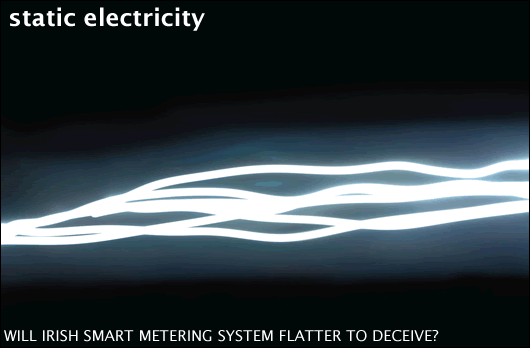
The announcement in 2007 of the introduction of Smart electricity metering led to widespread hope that Ireland could set a global example by empowering consumers to cut electricity use and generate their own renewable electricity. John Hearne investigates current progress on the initiative, and discovers signs that Ireland’s approach to smart metering could represent a missed opportunity.
With the smart metering pilot now underway, doubts are intensifying over the capacity of the project to deliver on its potential, as a demand management tool, as a means of consumer empowerment, as an incentive to microgeneration and most crucially as a means of placing our energy requirements on a more sustainable footing.
The regulator reports that recruitment for the customer behaviour trial of residential electricity consumers began in September and that take up has been ‘positive’. French electronics firm Sagem has been awarded the contract to supply smart metering equipment and systems. The benchmarking period, during which detailed consumption information will be collected from consumers, will run from next July for six months through to December. The second phase of the trial will run throughout 2010, during which ‘smart metering initiatives’ will be introduced and the resulting impact on consumer behaviour will be measured. Technology testing will also be carried out during this phase. Once the pilot is concluded, the Commission for Energy Regulation (CER) will carry out a cost/benefit analysis to evaluate the results and conclude on the business case for a full rollout, and crucially, the required functionality to support it.
The concern in the industry is that if the pilot does not road-test a sufficiently broad functionality, the subsequent cost/benefit analysis will misfire, delivering a national rollout that will fall far short of its potential. Despite repeated attempts by Construct Ireland to secure a detailed technical specification (as would have been provided to the companies which tendered for the pilot), neither the regulator, the Department of Communications, Energy and National Resources or ESB Networks were willing to disclose it. ESB Networks (ESBN) did however provide a ‘Technical Briefing Note on Smart Metering’ which does offer some insight into the direction in which the project is going.
Demand management
According to the Department of Energy, demand management of electricity is key to the success of the smart metering project. In response to questions submitted by Construct Ireland, the department said: “These meters will enable consumers to manage their electricity usage more efficiently, thereby cutting down on costs and reducing carbon emissions. Shifting demand away from peak time reduces the need for additional peaking plant, which tend to use high carbon fuels.” When launching the pilot in September, the energy regulator Dermot Nolan said that smart metering should lead to significant savings as well as “empowering consumers to have more information and control about their energy consumption”. In the specification however, the primary vehicle of consumer empowerment is the facility to introduce multiple tariffs, which will be modulated to drive use away from peak times. Mirroring the pricing structure in the pool, the smart metering system will be set up to capture 48 half-hourly reads every day, downloaded once a day from the meter to ESB Networks’ IT system. “Electricity suppliers can then use this highly granular data to bill customers on a range of tariffs.” Less emphasis is placed on empowering consumers through the provision of information, and none whatsoever, despite the regulator’s use of the word, on consumer control.
Provision of information is vital, and is referred to in the technical briefing document: “In the pilot ESB Networks in response to the requirements of the CER and industry will be installing low power radio chips in some of the user trial meters to communicate with a compatible in-home display. The in-home display will receive consumption data from the meter.”
The impact on consumer behavior of existing monitoring technology is well documented. “Without an electrician,” says sustainable design consultant Jay Stuart of DW EcoCo, “you can attach an electricity monitor onto the main cable of your electricity meter and it sends a readout in your kitchen showing your real time current consumption; a bit like a speedometer. The research shows that where it’s been installed, on average electricity consumption is reduced by 15%.” We don’t yet know how much real-time information will be available to households through the consumer behavior section of the pilot. Will the ‘consumption data’ to be provided by the ‘in-house display’ include, for example cost data, as opposed to less-compelling kWh data?
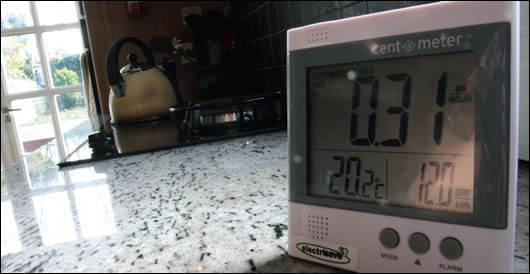
A plug-in electricity meter at the house of Bernard McCabe and Fionna Fox in Dublin's inner city gives a live read out of carbon emissions, temperature and electricity costs
Curiously, SEI is currently running a ‘Pilot Electricity Use Awareness Trial’, in which 500 homes, schools and businesses will participate in a project to examine the impact of consumption awareness on consumer behaviour. Electrical monitors which can display consumption information as power, cost or carbon dioxide emissions will be deployed in the trial and findings will then be used to assess what information formats are most effective in influencing electricity consumption. According to SEI, specific findings from the trial will inform the design and roll out of the national smart metering project. The 500 participants have been recruited from previous engagements with SEI – through House of Tomorrow funded housing developments and the Green Schools program, for example. Any behavioral conclusions arrived at from polling this small group of motivated consumers are likely to overstate the impact of awareness on behavior, and may subsequently mis-direct the national roll-out. Moreover, if the smart metering project is setting out to determine the same effects, albeit on a larger, more dispersed scale, why the duplication?
The central weakness in the specification relates to the decision to ignore systems which would allow the consumer to use power more intelligently around the house. Though the meter will be capable of registering a myriad of different tariffs, there are no plans to facilitate integration with a home area network or any facility which might allow the consumer to automate electricity use; turning off certain items at peak times and turning them on again during cheaper intervals. Though the CER’s project manager would not speak to Construct Ireland on this issue, business information centre manager in the regulator’s office, Paul Brandon did take some questions. “I don’t think it’s being looked at in great detail.” he says of consumer integration. “I know that there are a number of technologies out there which allow you to bring this as extra step further, but I think the plan…is to more or less try to look after the initial objectives that are on the consumption side to try to maybe see what impact it has on changing customers behavior. Arising out of that, depending on what results come from that, if the feedback from those customers is that this would be an area we’d like to explore a little bit further, we’d certainly consider building it into the national project, but likewise, what we’re saying is that whatever comes out of the results of the pilot project there still is scope for things to change in the national project.” If however the national roll out is based on a cost/benefit analysis of the pilot, the exclusion of functionality at the trial stage will, at the very least, tend towards its exclusion from the national roll out.
Tom Bean of Coolpower, like most of those who contributed to this article, welcomes the introduction of multiple tariffs. “When the network has its full load on, all the dirty stuff is on there. They’ve got peat stations, Moneypoint is going at full capacity, so all the carbon is going out into the atmosphere.” He does however doubt that the tariff introduced during that key 5pm to 7pm peak will be sufficient to change behavior, believing that social considerations will restrict it. It does seem logical however that a subset of consumers will respond to a higher price and their changed behavior will flatten the peak to some extent.
But that central issue remains. Without the capacity to integrate with domestic systems, smart metering cannot realize its full potential. If consumers are asleep or absent, they can’t react to high tariffs by switching off the heatpump or the deep freeze for an hour. A smart energy management meter, called EMMA has been developed and installed by Coolpower and can work in conjunction with smart meters. There is also potential through EMMA for remote management control by the grid operators. This, Bean believes, is where the market should focus to obtain maximum benefit. “What we believe should happen,” he says, “is the smart meter should interface to some sort of device to control the power. We can just turn things on and off based on your profile, and if they ever change the pricing, you in theory would never have to do anything, the system itself would control things. A further step; we could even imagine a time where control is given to the grid. Maybe this is too sci-fi for some people, but ultimately if the grid could turn around and say I’m up at 5,300 Megawatts here and if this goes to 5,400 MW I’m in trouble, can I get 100MW of power somewhere, and what it needs to do is go out and find 100MW of power and turn it off.” The reality is however that this type of functionality is being road-tested in the pilot. Again, that ESB Networks briefing document says: “The meter will have an embedded switch which could be operated remotely in addition to a control device which could limit electricity going into a premises.” So while the new systems will deliver control to the grid, the consumer does not get the same privileges.
This skewed emphasis is evident in both functionality and through the pilot. The communication systems, which will also facilitate upgrading of firmware remotely, remove the need for meter readings. Consumers can be cut off remotely. The systems will be designed to detect tampering, the theft of power, and connection with unapproved equipment. A smart metering prepayment system – which would remove billing and administrative costs and free up cashflow for the grid – is also under development and will be tested during the trial. We do not know the value of the pilot project, but costs of the full roll out of the system, estimated at e1bn are expected to be borne by the consumer.
John Quinn of Surface Power believes that the failure to even facilitate consumer integrations represents a huge lost opportunity in the drive to manage our energy needs. “That meter is a much bigger device. It shouldn’t just be about the energy that’s going through it, it should be about the building itself, it should be a stepping stone between other products and software and technology that can interact with the building. All of that will be lost if those interface protocols are not in it.”
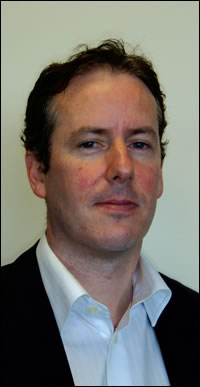 |
| CER Energy Regulator Dermot Nolan |
Microgeneration
There is a commitment in the program for government to facilitate the introduction of net metering to allow consumers to sell electricity back into the grid from renewable power supplies. However, the regulator’s decision paper on arrangements for microgeneration published late last year stated that net metering, which would automatically reverse the direction of a standard non interval meter was not a viable option. Instead: “The commission considers that smart metering offers the best prospect for economic measurement in that smart meters have the capability to distinguish between import and export on a settlement period basis.”
Asked if the decision paper trumps the program for government, Paul Brandon said: “Through the smart metering project, we’re planning to go further than the original government position on net metering and effectively, it doesn’t really ‘trump’ the government position…but rather it supersedes it in that it will allow for the objectives of net metering which was to allow people to receive payment. That will happen.”
The sole sentence on microgeneration in ESB Networks’ technical briefing document runs as follows: “If a customer was exporting the meter would also bring back a daily export read.”
According to the CER, details on how exporters might be remunerated have yet to be nailed down. Paul Brandon stated strongly that the tariff will incentivize microgeneration. “You effectively get one shot at it, so we have to make sure that it is a useful proposal that we put forward on it.” He went on to say that his office intended to consult with the industry both on physically recording electricity generated by the microgenerator and on how a tariff might be structured. This latter issue is key.
One of the regulator’s three objections to net metering using the old style meter in the December decision paper was the fact that the time at which the electricity was generated couldn’t be determined by this technology, and as such, could not “facilitate payment that reflects the value of such output to the system”. This objection would suggest that the regulator will eventually deliver a range of time based tariffs as opposed to a flat fee. That is if ESB Networks’ daily export read does not preclude this.
The regulator’s primary objection to net metering ran as follows: “It would result in the incorrect remuneration of the micro generator since it is estimated that only around two thirds of the costs recovered by a supply tariff are typically avoidable by the purchase of micro generated electricity.” This would suggest that the tariff is being structured on limited cost/benefit grounds, without reference to the carbon savings which would accrue from switching to clean microgenerated power.
In a separate move, SEI recently put out a call for proposals under a new programme to assess the technical, financial and regulatory issues surrounding the deployment of small and micro scale generation technologies in Ireland. “The trial,” according to SEI, “will contribute to ongoing work to assess the amount of electricity exported from micro-generation and the metering and tariff options available to compensate the micro-generation installations according to the value of the electricity exported in a cost-effective manner. This will support parallel work being carried out on the options for commercial arrangements for micro and small scale generation.” Again, the implication is that remuneration will not take carbon savings into account.
Peter Keavney of the Galway Energy Agency has grown skeptical of the project’s capacity to work with microgenerators and does not believe that we will end up with pricing bands which vary throughout the day. If we do, he points to a vulnerability in such a system that could actually lead to an increase in Ireland’s carbon emissions. “If they start bringing in prices at different times, someone might look at the possibility of buying a load of batteries, buying electricity from ESB when it’s for nothing and selling it back to them between 5pm and 7pm and making a fortune out of it.” He also points to the fact that the smart metering project was launched without reference to microgeneration, net metering or renewables. In the UK, meanwhile, the government matches the price paid to microgenerators with a Renewables Obligation Certificate payment.
Any pricing mechanism that is blind to the cleanliness of the power or the pressure it removes from the grid cannot possibly incentivize microgeneration. Moreover, there are opportunity costs to the ESB in failing to support small scale electricity generation. “What you’re buying in from the ESB,” says Peter Keavney, “has huge (transmission) losses and there are virtually no losses with your own generation.” He goes on: “We do not want to get paid per kilowatt hour, we’re not in the business of generating electricity. Anybody that puts in a generator is in the business of cutting carbon dioxide. It’s a renewable energy…Our current carbon intensity of electricity is 601 grams of carbon dioxide per kilowatt hour, so if you generate a unit of electricity and you put it on the grid, you should actually get paid per gram of carbon dioxide saved.”
The smart metering system’s ability, or indeed inability to talk to other systems also has a significant bearing on microgeneration. Coolpower’s EMMA system, for example, can manage power systems and facilitate the storage of surplus power as hot water. “The ultimate goal,” says Chris Maassen of Maassen Sustainable Energy who has recently installed the EMMA system, “would be a smart meter that works with controllers. If at twelve o’clock, ESB reaches peak time and says we need now whatever power’s available, we’ll give you 20c for it, my controller switches automatically to export and bangs out the energy to the grid.” Tariff structure is central to growth of microgeneration. Making the process of set up, power export and control as simple as it possibly can be is also vital. At present, there is nothing in the spec to facilitate that level of control.
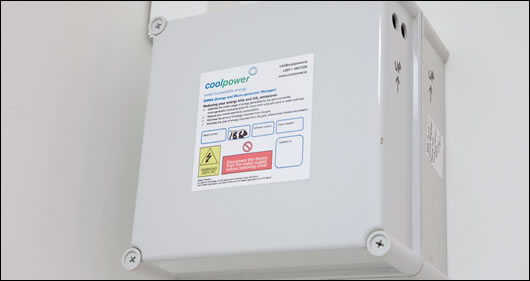
Coolpower’s EMMA system can manage power systems and facilitate the storage of surplus power as hot water
At Surface Power, John Quinn says that we need to take the time to build the system properly. “It was absolutely loud and clear to the DSO (distribution system operator) and to everybody that this meter should be the most advanced product possible.” He believes however that the timeline for project delivery is just too short, and that the technology required to truly deliver on its potential won’t be included. “Essentially the smart meter could be the new computer. All of the products and services that are built onto the computer could be built on top of a smart network as well.”
The central question is whether or not the political dynamics in the project will repress all objectives but those of communication and centralized control. Paul Brandon believes not. “I think we as the regulator have to strike a balance between competing objectives. The minister is very keen on the concept of consumer empowerment through smart metering. The grid can see the advantages from their side in terms of information gathering, reductions in meter readings, that sort of thing but from our side, we want to get as much out of it as possible. The original objectives were on the consumer side and some of the other things have been tagged on to the project. That’s not to say that they are important as well, but we are certainly doing our best not to lose sight of what the original objectives in the project were.”
- Articles
- renewable energy
- Static electricity
- cool power
- metering
- commission for energy regulation
- esb
- EMMA
Related items
-
 SEAI Energy Awards 2020 open for entries
SEAI Energy Awards 2020 open for entries -
 The first oil crisis
The first oil crisis -
 SEAI Energy Show back at RDS on 27 & 28 March
SEAI Energy Show back at RDS on 27 & 28 March -
 Energywise Ireland open new renewables showroom
Energywise Ireland open new renewables showroom -
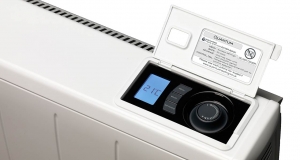 Together in Electric Dreams
Together in Electric Dreams -
 Major office scheme passes DLR’s passive house or equivalent policy
Major office scheme passes DLR’s passive house or equivalent policy -
 Passive House Plus back issues now freely available online
Passive House Plus back issues now freely available online -
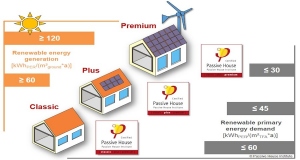 Passive House Institute launches new cert categories
Passive House Institute launches new cert categories -
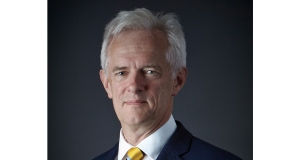 Passive house: an alternative method of meeting Part L?
Passive house: an alternative method of meeting Part L? -
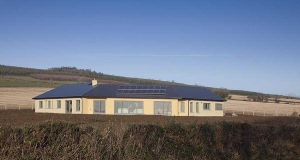 Do Ireland’s energy efficiency regulations penalise energy efficiency?
Do Ireland’s energy efficiency regulations penalise energy efficiency? -
 Ireland’s energy roadmap — have your say
Ireland’s energy roadmap — have your say -
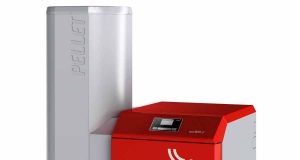 Windhager to launch new BioWin 2 pellet boiler at Ecobuild
Windhager to launch new BioWin 2 pellet boiler at Ecobuild

